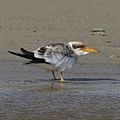| Large-billed tern | |
|---|---|
 | |
| at Cuiaba river, Pantanal, Mato Grosso state, Brazil | |
| Scientific classification | |
| Kingdom: | Animalia |
| Phylum: | Chordata |
| Class: | Aves |
| Order: | Charadriiformes |
| Family: | Laridae |
| Genus: | Phaetusa Wagler, 1832 |
| Species: | P. simplex |
| Binomial name | |
| Phaetusa simplex (Gmelin, JF, 1789) | |
 | |
The large-billed tern (Phaetusa simplex) is a species of tern in the family Laridae. It is placed the monotypic genus Phaetusa. It is found in most of South America (east of the Andes and north of the Pampas). It has occurred as a vagrant in Aruba, Bermuda, Cuba, Panama and the United States. Its natural habitats are rivers and freshwater lakes.








